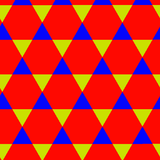
Trihexagonal tiling
Encyclopedia
In geometry
, the trihexagonal tiling is a semiregular tiling of the Euclidean plane. There are two triangles and two hexagons alternating on each vertex
. It has Schläfli symbol of t1{6,3}; its edges form an infinite arrangement of lines
.
Conway
calls it a hexadeltille, combining alternate elements from a hexagonal tiling (Hextille) and triangular tiling (deltille).
There are 3 regular and 8 semiregular tilings in the plane.
s of a trihexagonal tiling. (Naming the colors by indices on the 4 faces around a vertex (3.6.3.6): 1212, 1232.)
polyhedra with vertex figure
(3.n.3.n) and (*n32) reflectional symmetry.
This tiling is also topologically part of sequence of polyhedra and tilings with vertex figure (3.2n.3.2n) and (*n33) reflectional symmetry.
A tiling with alternate large and small triangles is topologically identical to the trihexagonal tiling. The hexagons are distorted so 3 vertices are on the mid-edge of the larger triangles. Similarly there are two uniform colorings:
Geometry
Geometry arose as the field of knowledge dealing with spatial relationships. Geometry was one of the two fields of pre-modern mathematics, the other being the study of numbers ....
, the trihexagonal tiling is a semiregular tiling of the Euclidean plane. There are two triangles and two hexagons alternating on each vertex
Vertex (geometry)
In geometry, a vertex is a special kind of point that describes the corners or intersections of geometric shapes.-Of an angle:...
. It has Schläfli symbol of t1{6,3}; its edges form an infinite arrangement of lines
Arrangement of lines
In geometry an arrangement of lines is the partition of the plane formed by a collection of lines. Bounds on the complexity of arrangements have been studied in discrete geometry, and computational geometers have found algorithms for the efficient construction of arrangements.-Definition:For any...
.
Conway
John Horton Conway
John Horton Conway is a prolific mathematician active in the theory of finite groups, knot theory, number theory, combinatorial game theory and coding theory...
calls it a hexadeltille, combining alternate elements from a hexagonal tiling (Hextille) and triangular tiling (deltille).
There are 3 regular and 8 semiregular tilings in the plane.
Uniform colorings
There are two distinct uniform coloringUniform coloring
In geometry, a uniform coloring is a property of a uniform figure that is colored to be vertex-transitive...
s of a trihexagonal tiling. (Naming the colors by indices on the 4 faces around a vertex (3.6.3.6): 1212, 1232.)
| Coloring |  |
 |
|---|---|---|
| Wythoff symbol Wythoff symbol In geometry, the Wythoff symbol was first used by Coxeter, Longeut-Higgens and Miller in their enumeration of the uniform polyhedra. It represents a construction by way of Wythoff's construction applied to Schwarz triangles.... |
2 | 6 3 | 3 3 | 3 |
| Coxeter-Dynkin diagram Coxeter-Dynkin diagram In geometry, a Coxeter–Dynkin diagram is a graph with numerically labeled edges representing the spatial relations between a collection of mirrors... |
Related polyhedra and tilings
This tiling is topologically part of sequence of rectifiedRectification (geometry)
In Euclidean geometry, rectification is the process of truncating a polytope by marking the midpoints of all its edges, and cutting off its vertices at those points...
polyhedra with vertex figure
Vertex figure
In geometry a vertex figure is, broadly speaking, the figure exposed when a corner of a polyhedron or polytope is sliced off.-Definitions - theme and variations:...
(3.n.3.n) and (*n32) reflectional symmetry.
 (3.3.3.3) Octahedron In geometry, an octahedron is a polyhedron with eight faces. A regular octahedron is a Platonic solid composed of eight equilateral triangles, four of which meet at each vertex.... (*332) and (*432) |
 (3.4.3.4) Cuboctahedron In geometry, a cuboctahedron is a polyhedron with eight triangular faces and six square faces. A cuboctahedron has 12 identical vertices, with two triangles and two squares meeting at each, and 24 identical edges, each separating a triangle from a square. As such it is a quasiregular polyhedron,... (*432) |
 (3.5.3.5) Icosidodecahedron In geometry, an icosidodecahedron is a polyhedron with twenty triangular faces and twelve pentagonal faces. An icosidodecahedron has 30 identical vertices, with two triangles and two pentagons meeting at each, and 60 identical edges, each separating a triangle from a pentagon... (*532) |
 (3.6.3.6) (*632) |
 (3.7.3.7) Triheptagonal tiling In geometry, the triheptagonal tiling is a semiregular tiling of the hyperbolic plane, representing a rectified Order-3 heptagonal tiling. There are two triangles and two heptagons alternating on each vertex... (*732) |
 (3.8.3.8) (*832) |
This tiling is also topologically part of sequence of polyhedra and tilings with vertex figure (3.2n.3.2n) and (*n33) reflectional symmetry.
 (3.4.3.4) (*233) |
 (3.6.3.6) (*333) |
 (3.8.3.8) (*433) |
A tiling with alternate large and small triangles is topologically identical to the trihexagonal tiling. The hexagons are distorted so 3 vertices are on the mid-edge of the larger triangles. Similarly there are two uniform colorings:
 |
 |

